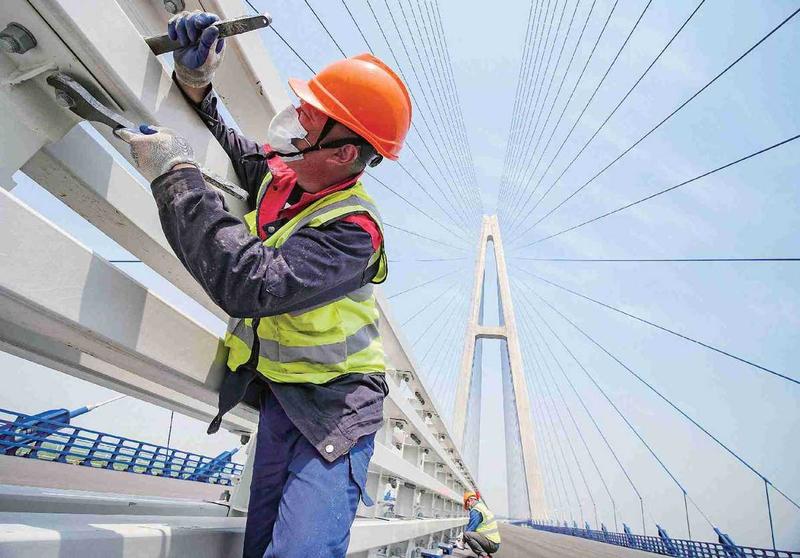 A worker at the construction site of a new Yangtze River bridge in Wuhan, Hubei province. (PHOTO / CHINADAILY.COM.CN)
A worker at the construction site of a new Yangtze River bridge in Wuhan, Hubei province. (PHOTO / CHINADAILY.COM.CN)
Hubei province in Central China is slowly emerging from the novel coronavirus shadow, as a raft of economic indicators released on Tuesday pointed to a sequential recovery, despite the drop in economic output during the first three months of the year.
Hubei, which was ravaged by the epidemic, said its first-quarter GDP fell by 39.2 percent on a yearly basis, according to the Hubei Provincial Bureau of Statistics.
Though Hubei's economy experienced a deep contraction in the first quarter, experts expressed the view that Hubei would stage a rapid recovery during the second quarter, particularly in the May-June period.
ALSO READ: Hubei snack food makers shrug off small impact
Supportive policies are set to intensify over the next few months to hedge the epidemic effect on Hubei, with a key focus on expanding internal demand and resolving issues faced by the local companies during work resumptions.
The added value of major industrial enterprises in Hubei fell by 46.9 percent on a yearly basis in March, but the decline narrowed by 32.9 percentage points from the level in February, according to the Hubei statistics bureau.
Among the 41 industries surveyed by the bureau, 27 reported lower industrial production levels but at a much narrower pace in March than the two months of the year.
Ye Qing, deputy head of the bureau, said the province was hit badly by the novel coronavirus outbreak, and experienced months of lockdowns and restrictions as part of the efforts to curb the spread of the epidemic.
"Despite the economic contraction, Hubei's recovery has gained a firm footing with its solid industrial foundation, huge market potential and its strong innovation capabilities," Ye said.
By April 14, major companies in Hubei reported a work resumption rate of 98 percent, 88.3 percentage points higher than that on March 11. Nearly 87.9 percent of the employees had returned to work in the province, according to official data.
Ye said the key is to further accelerate work resumptions and ensure that production levels reach the precrisis levels. That said, more efforts are also needed to resolve work resumption problems faced by companies, introduce more supportive policies such as offering interest-free loans and increasing the subsistence allowances for both urban and rural residents.
Amid the disruptions caused by the epidemic, Hubei also witnessed new growth opportunities in fields such as online shopping, Ye said.
Hubei-based livestreaming platform Douyu recently launched a four-day livestreaming event to promote Hubei specialties. The platform said it sold local specialties valued at 30.34 million yuan (US$4.7 million) and attracted 34.31 million online viewers.
Chen Shaojie, CEO of Douyu, said the company is part of Hubei, and it hoped to use the new model that combines livestreaming and e-commerce to sell more Hubei products.
Pan Helin, executive director of the Digital Economy Academy of the Zhongnan University of Economics and Law in Hubei, said new businesses such as online livestreaming will help inject fresh impetus.
READ MORE: Hubei farmers look to net crawfish bonanza
"I believe that Hubei will quickly regain momentum, especially with the help of government measures to minimize the epidemic effect. The province will also benefit from the huge investments of big companies such as Tencent as well as its emerging high-tech industries.
"Despite the increasing downward pressure, the government must come up with more measures to promote the coordinated resumption of the industrial chain operations. The supportive policies should be intensified in the next few months to help Hubei weather the economic fallout of the epidemic by further reducing fees and taxes for both companies and individuals."


